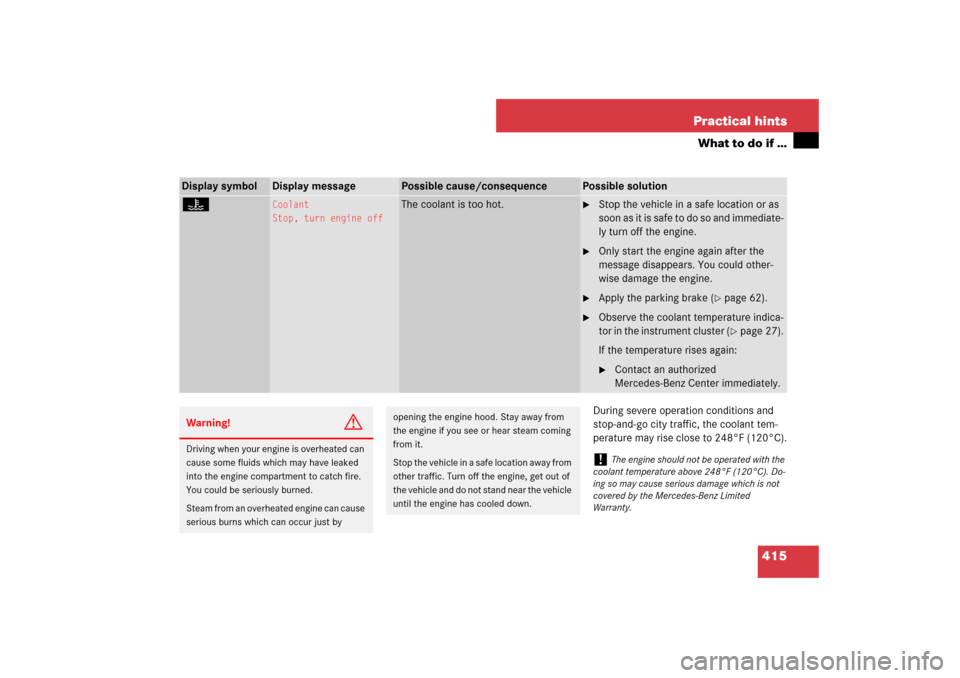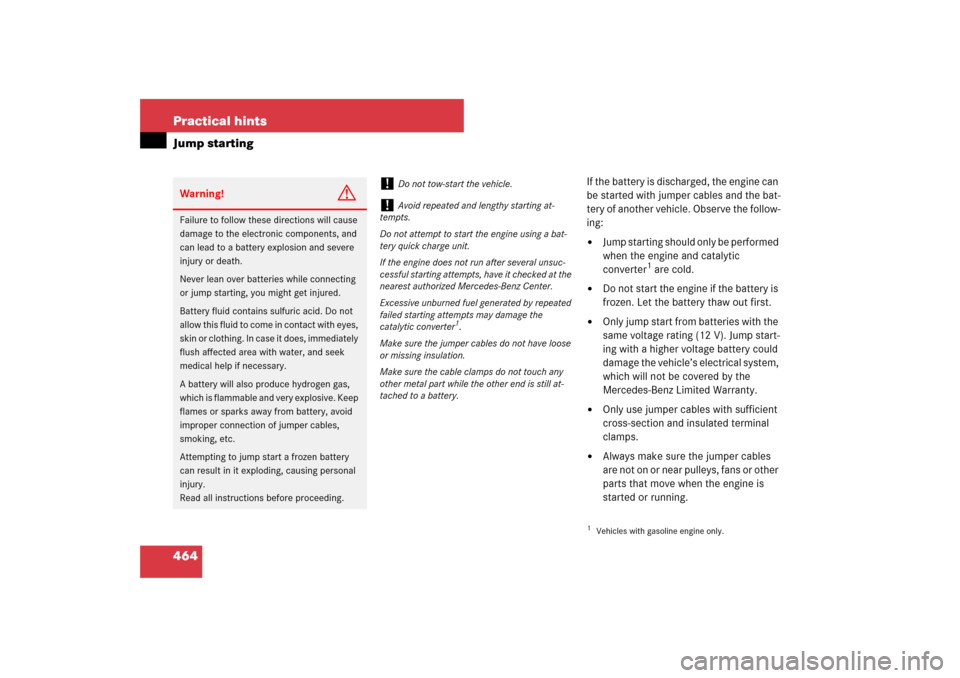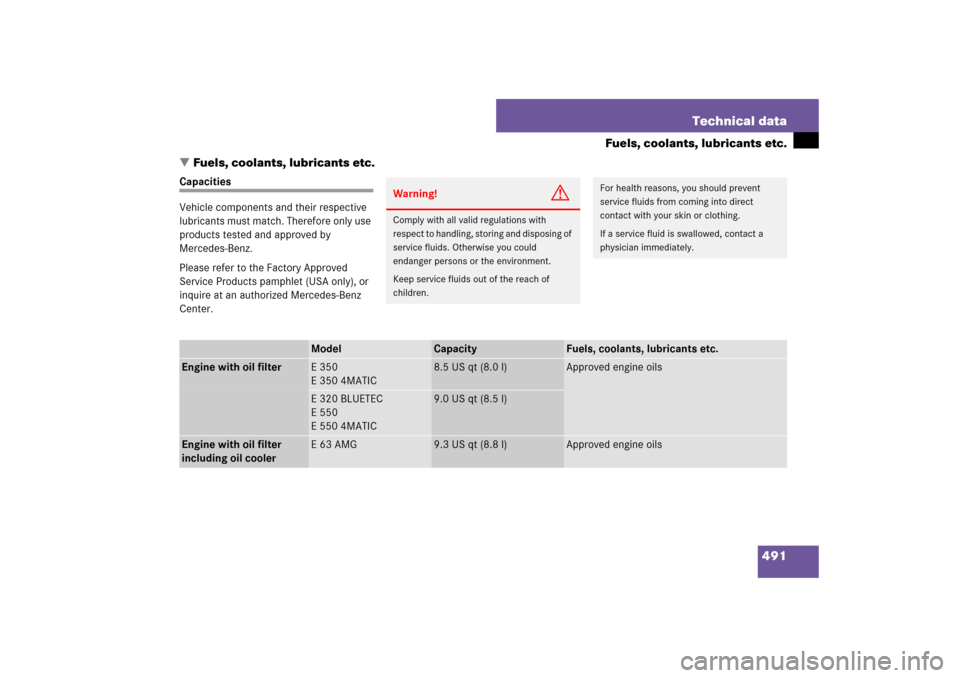Page 414 of 522

413 Practical hints
What to do if …
Display symbol
Display message
Possible cause/consequence
Possible solution
(USA only);(Canada only)3
EBV, ABS, ESP
inoperative
See Operator’s Man.
ABS, ESP
®, EBP as well as PRE-SAFE
®
have switched off due to a malfunction.
BAS is also switched off.
The brake system is still functioning nor-
mally but without the ABS, BAS, ESP
® and
PRE-SAFE
® available.
�
Continue driving with added caution.
�
Adjust driving to be consistent with
reduced braking responsiveness.
�
Visit an authorized Mercedes-Benz
Center as soon as possible.
Release parking
brake
You are driving with the parking brake
set.
�
Release the parking brake
(�page 55).
Check
brake fluid level
There is insufficient brake fluid in the
reservoir.
�
Risk of accident! Stop the vehicle in a
safe location as soon as it is safe to do
so and notify an authorized
Mercedes-Benz Center. Do not add
brake fluid! This will not solve the
problem.
Warning!
G
Driving with the message
Check brake
fluid level
displayed can result in an ac-
cident. Have your brake system checked im-
mediately.
Do not add brake fluid before checking the
brake system. Overfilling the brake fluid res-
ervoir can result in spilling brake fluid on hot
engine parts and the brake fluid catching
fire. You can be seriously burned.
!
If you find that the brake fluid in the brake
fluid reservoir has fallen to the minimum mark or
below, have the brake system checked for brake
pad thickness and leaks.
Page 416 of 522

415 Practical hints
What to do if …
During severe operation conditions and
stop-and-go city traffic, the coolant tem-
perature may rise close to 248°F (120°C).
Display symbol
Display message
Possible cause/consequence
Possible solution
•
Coolant
Stop, turn engine off
The coolant is too hot.
�
Stop the vehicle in a safe location or as
soon as it is safe to do so and immediate-
ly turn off the engine.
�
Only start the engine again after the
message disappears. You could other-
wise damage the engine.
�
Apply the parking brake (
�page 62).
�
Observe the coolant temperature indica-
tor in the instrument cluster (
�page 27).
If the temperature rises again:
�
Contact an authorized
Mercedes-Benz Center immediately.
Warning!
G
Driving when your engine is overheated can
cause some fluids which may have leaked
into the engine compartment to catch fire.
You could be seriously burned.
Steam from an overheated engine can cause
serious burns which can occur just by
opening the engine hood. Stay away from
the engine if you see or hear steam coming
from it.
Stop the vehicle in a safe location away from
other traffic. Turn off the engine, get out of
the vehicle and do not stand near the vehicle
until the engine has cooled down.
!
The engine should not be operated with the
coolant temperature above 248°F (120°C). Do-
ing so may cause serious damage which is not
covered by the Mercedes-Benz Limited
Warranty.
Page 431 of 522
430 Practical hintsWhat to do if …Display symbol
Display message
Possible cause/consequence
Possible solution
t
Function
unavailable
This display appears if button t or
s on the multifunction steering wheel
is pressed and the vehicle is not equipped
with a telephone.
W
Top up
washer fluid
The fluid level has dropped to about
1/3 of
total reservoir capacity.
�
Add washer fluid (
�page 332).
Ê
The trunk is open.
�
Close the trunk.
Y
You are driving with the hood open.
�
Stop the vehicle in a safe location as
soon as it is safe to do so.
�
Close the hood (
�page 327).
There is otherwise danger of an accident.
V
You are driving with one or more doors
open.
The display symbol shows you which
doors are open.
�
Close the doors.
@
Vehicle rising
Your vehicle is adjusting to your level se-
lection.
Page 461 of 522

460 Practical hintsBatteryThe battery is located on the right hand
side of the trunk under the luggage box
(�page 433).
Vehicles with spare wheel1Positive terminal
2Negative terminal
3Battery bracket
4Battery ventilation hose
Warning!
G
Failure to follow these instructions can re-
sult in severe injury or death.
Observe all safety instructions and precau-
tions when handling automotive batteries
(�page 331).
Never lean over batteries while connecting,
you might get injured.
Battery fluid contains sulfuric acid. Do not
allow this fluid to come in contact with eyes,
skin or clothing. In case it does, immediately
flush affected area with water and seek
medical help if necessary.
A battery will also produce hydrogen gas,
which is flammable and explosive. Keep
flames or sparks away from battery, avoid
improper connection of jumper cables,
smoking etc.
!
Depending on vehicle production date, the
battery is a V
alve-R
egulated L
ead A
cid (VRLA)
battery, also referred to as “fleece” battery:
Such batteries do not require topping-up of the
electrolyte level. VRLA batteries therefore do not
have cell caps and the battery cover is non-re-
movable. Do not attempt to open the battery as
otherwise the battery will be damaged.
Even though VRLA batteries do not require top-
ping-up of the electrolyte level and cannot be
opened to check the electrolyte level, the bat-
tery condition must be checked periodically by
performing a battery conductance test. Refer to
Maintenance Booklet for battery condition test-
ing intervals.
The factory-equipped VRLA battery is
leak-proofed. Only use a battery as replacement
that has the same security features and is of
identical size, voltage, and capacity as the
factory-equipped battery.
Page 465 of 522

464 Practical hintsJump starting
If the battery is discharged, the engine can
be started with jumper cables and the bat-
tery of another vehicle. Observe the follow-
ing:�
Jump starting should only be performed
when the engine and catalytic
converter
1 are cold.
�
Do not start the engine if the battery is
frozen. Let the battery thaw out first.
�
Only jump start from batteries with the
same voltage rating (12 V). Jump start-
ing with a higher voltage battery could
damage the vehicle’s electrical system,
which will not be covered by the
Mercedes-Benz Limited Warranty.
�
Only use jumper cables with sufficient
cross-section and insulated terminal
clamps.
�
Always make sure the jumper cables
are not on or near pulleys, fans or other
parts that move when the engine is
started or running.
Warning!
G
Failure to follow these directions will cause
damage to the electronic components, and
can lead to a battery explosion and severe
injury or death.
Never lean over batteries while connecting
or jump starting, you might get injured.
Battery fluid contains sulfuric acid. Do not
allow this fluid to come in contact with eyes,
skin or clothing. In case it does, immediately
flush affected area with water, and seek
medical help if necessary.
A battery will also produce hydrogen gas,
which is flammable and very explosive. Keep
flames or sparks away from battery, avoid
improper connection of jumper cables,
smoking, etc.
Attempting to jump start a frozen battery
can result in it exploding, causing personal
injury.
Read all instructions before proceeding.
!
Do not tow-start the vehicle.
!
Avoid repeated and lengthy starting at-
tempts.
Do not attempt to start the engine using a bat-
tery quick charge unit.
If the engine does not run after several unsuc-
cessful starting attempts, have it checked at the
nearest authorized Mercedes-Benz Center.
Excessive unburned fuel generated by repeated
failed starting attempts may damage the
catalytic converter
1.
Make sure the jumper cables do not have loose
or missing insulation.
Make sure the cable clamps do not touch any
other metal part while the other end is still at-
tached to a battery.
1Vehicles with gasoline engine only.
Page 492 of 522

491 Technical data
Fuels, coolants, lubricants etc.
�Fuels, coolants, lubricants etc.
Capacities
Vehicle components and their respective
lubricants must match. Therefore only use
products tested and approved by
Mercedes-Benz.
Please refer to the Factory Approved
Service Products pamphlet (USA only), or
inquire at an authorized Mercedes-Benz
Center.
Warning!
G
Comply with all valid regulations with
respect to handling, storing and disposing of
service fluids. Otherwise you could
endanger persons or the environment.
Keep service fluids out of the reach of
children.
For health reasons, you should prevent
service fluids from coming into direct
contact with your skin or clothing.
If a service fluid is swallowed, contact a
physician immediately.
Model
Capacity
Fuels, coolants, lubricants etc.
Engine with oil filter
E 350
E 350 4MATIC
8.5 US qt (8.0 l)
Approved engine oils
E 320 BLUETEC
E 550
E 550 4MATIC
9.0 US qt (8.5 l)
Engine with oil filter
including oil cooler
E63AMG
9.3 US qt (8.8 l)
Approved engine oils
Page 493 of 522
492 Technical dataFuels, coolants, lubricants etc.
Model
Capacity
Fuels, coolants, lubricants etc.
Automatic transmission
E 320 BLUETEC
E 350
E 550
9.7 US qt (9.2 l)
MB Automatic Transmission Fluid
E 350 4MATIC
E 550 4MATIC
8.6 US qt (8.1 l)
E63AMG
9.0 US qt (8.5 l)
ATF 3353
Front axle
E 350 4MATIC
E 550 4MATIC
1.69 US qt (1.6 l)
Hypoid gear oil SAE 85 W 90
Rear axle
E 350
1.06 US qt (1.0 l)
Hypoid gear oil SAE 85 W 90
E 320 BLUETEC
E 550
1.37 US qt (1.3 l)
E 350 4MATIC
E 550 4MATIC
1.69 US qt (1.6 l)
E63AMG
1.27 US qt (1.2 l)
Transfer case
E 350 4MATIC
E 550 4MATIC
0.62 US qt (0.585 l)
MB Transfer Case Fluid
Page 494 of 522
493 Technical data
Fuels, coolants, lubricants etc.
Model
Capacity
Fuels, coolants, lubricants etc.
Power steering
approx. 0.95 US qt (0.9 l)
MB Power Steering Fluid
(Pentosin CHF 11S or, depending on vehicle
production date, Chevron Texaco PSF 9109)
1
1For detailed information, please refer to the Factory Approved Service Products pamphlet (USA only) or contact an authorized Mercedes-Benz Center.
E63AMG
1.3 US qt (1.2 l)
Front wheel hubs
approx. 3.0 oz (85 g) each
High temperature roller bearing grease
E63AMG
3.2 oz (90 g) each
Brake system
0.63 US qt (0.6 l)
MB Brake Fluid (DOT 4+)
Cooling system
E320BLUETEC
13.7 US qt (13.0 l)
MB 325.0 Anticorrosion/Antifreeze
E350
E3504MATIC
10.7 US qt (10.0 l)
E550
E5504MATIC
11.9 US qt (11.3 l)
E63AMG
12.5 US qt (11.8 l)